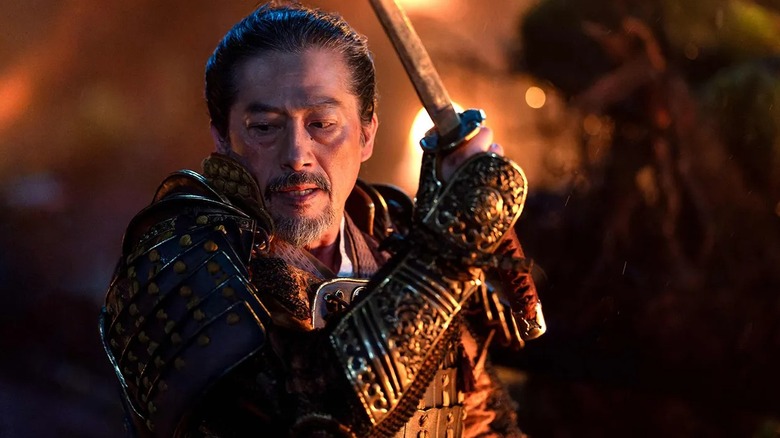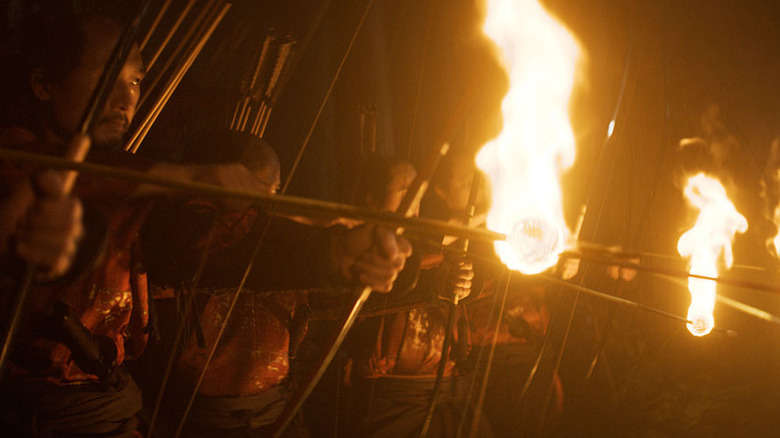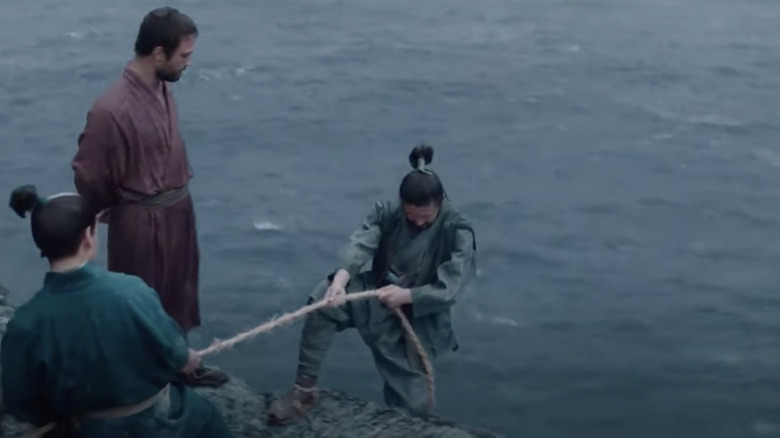All Of Shogun's Arrows And Blood Came From The Power Of Visual Effects
FX's historical drama series "Shōgun" has rightfully earned high marks, including for its recreation of 1600 Japan. Would you believe the show was actually shot on sets built in Vancouver? I certainly didn't, but it's true. (The Japanese cast lends some extra verisimilitude, but they couldn't carry the production design and effects teams completely.)
"Shōgun" has begot endless comparisons to "Game of Thrones." Like in Westeros, battles in the series are most often waged via conversation, not sword fights. Language is a dominant theme of "Shōgun," with the show often underlining the contrast between strict Japanese decorum, even among enemies, and the brutal physical violence those enemies inflict on each other. Even the ending of "Shōgun" is an anti-climax designed to surprise those expecting an epic battle.
When battles do erupt, though, they're as bloody as you'd expect Samurai clashes to be. Episode 4, "The Eightfold Fence," ends with a squad of soldiers being ambushed with a blast of cannonballs; the men and their horses collapse into piles of gore. That gore, though, was created with CG (by Portland, Oregon studio Refuge VFX, specifically — take a closer look at their work here).
Michael Cliett, the series' VFX supervisor, confirmed that the series contracted six other VFX houses besides Refuge. The goal on "Shōgun" was invisible VFX, augmenting the physical spaces and sets built by production designer Helen Jarvis and her team, instead of using only green screens to recreate Japanese cities/villages of old. The CG in "Shōgun" is there to heighten the authenticity, not to distract.
Cliett in turn discussed some particularly bloody VFX scenes during a Reddit AMA (as well as disclosing one time they went for practical gore instead).
The invisible VFX of Shōgun
Episode 2 of "Shōgun" — "Servants of Two Masters" — ends with a foiled assassination attempt on Lord Yoshi Toranaga (Hiroyuki Sanada). The shinobi killer (Mao Asou) slices a maid's throat open and her blood splatters on a shoji screen, creating a color-on-white-paper pattern not unlike Japanese calligraphy. Cliett noted in his AMA that he "loved this shot" — but the blood splatter effect was CG. After all, that way the episode's director (Jonathan van Tulleken) has greater control over how the blood splatters in the final scene and there's no need to worry about cleaning the set across multiple takes.
In the subsequent episode 3, "Tomorrow is Tomorrow," Toranaga and co. try to flee the city of Osaka. Once night has fallen, they're ambushed in a forest by enemy archers wielding arrows set on fire. The archers and the bows were real, but the flaming arrows were CGI (created by Los Angeles studio Barnstorm). Making actors handle real flaming arrows and firing them into a crowd? That sounds like an unsafe environment to me.
Cliett initially claimed that "No practical blood was ever used" during his AMA, but quickly retracted and revealed there was some used in episode 8, "The Abyss of Life." In said episode, Toranaga's right-hand man Toda Hiromatsu (Tokuma Nishioka) commits seppuku as part of a ploy by his lord. It's one of the show's many instances showing how feudal service in Japan often called on vassals to give their lives. Hiromatsu slices open his own stomach and is then decapitated by his own son, Buntaro (Shinnosuke Abe).
Not all of the VFX in Shōgun are in the battles
Cliett confirmed that for Hiromatsu's death scene, the crew combined CG and practical effects.
"We did utilize a blood bag and stomach prosthetic with SPFX [special effects]. But we did do significant amounts of additional blood as well as a cg stomach as the blade moves through on the [close-up]. The head coming off was full cg but the rolling head was a practical prosthetic with some augmentation and a VFX blood trail across the floor."
Blood wasn't the only liquid that "Shōgun" pulled out VFX for. In the first episode "Anjin," the sailor Vasco Rodrigues (Néstor Carbonell) goes overboard. The other characters find him washed ashore at the base of a coastal cliff and have to rappel down to rescue him. The height and aggressive waves make the job difficult — but the cliff was a set and the water VFX. Cliett explained that this was about making the environment realistic for the viewers; representing the ocean with matte paintings would result in "too much parallax." He continued:
"They look out to sea in all directions as they approach the cliff. The entire environment — ocean, water, waves and rocks – all had to be built in 3D because we were shooting in a field on a 'cliff' positioned two meters above a bluescreen — not near the coast at all."
Whether in creating something as small as a blood splatter or as big as the sea, "Shōgun" proves VFX can augment eye-stopping practical effects without anyone knowing the CGI is there.
"Shōgun" is streaming on FX and has been renewed for two further seasons.


